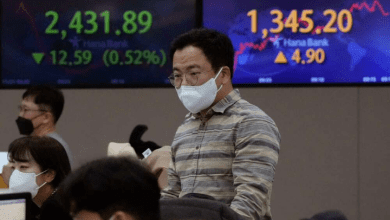
Banks’ rate of client borrowing rises to 29.13%
As of the end of December 2022, the maximum loan rate in the banking industry was 29.13%, while the return on savings deposits was 4.13%.
Data on money market indicators received from the Central Bank of Nigeria were made public on Monday.
The report states that the prime loan rate was 13.85% and the interbank call rate was 12%.
Treasury bill rates were 4.35 percent, while deposit rates for one month were 8.15 percent, three months were 3.79 percent, six months were 8.68 percent, and twelve months were 8.22 percent.
The Monetary Policy Rate was 16.5 percent for the time period under consideration.
In its blueprint report for the growth, development, and sustainability of the micro, small, and medium-sized enterprise sector in Nigeria, the National Institute of Credit Administration stated that businesses needed to be supported with single-digit loans because high interest rates were hindering economic growth.
The statement said, “The interest rate payable on loans and lines of credits granted to MSMEs in the nation would increase in direct proportion to the Monetary Policy Rate. Any MSME must bear the burden of high interest rates.
According to NICA, many MSMEs have to balance a number of economic concerns while operating their businesses.
“Because of the MSMEs’ size and resources, these variables have a substantial influence on their profitability,” it was claimed. In order to prevent the issues from becoming worse, it is important for MSMEs to have “Not too tough” access to single-digit loans. More sector-specific funds should be developed by CBN and the development banks so that MSMEs may access them with low interest rates and minimal restrictions.
By enacting tailored tax incentive programs, the federal government may accelerate growth and development in the MSME sector.
“While this may immediately result in a decrease in the government’s ability to generate income, especially at this critical time of declining government revenue, the advantages to the economy over the medium to long term cannot be overstated. In some circumstances, the federal government may provide tax benefits.
The Monetary Policy, according to the report, refers to the particular steps taken by the Central Bank to control the value, supply, and cost of money in the economy with the intention of attaining the macroeconomic goals of the government, while other times they are not.
It was noted that although monetary policy goals might differ from nation to nation, there were primarily two points of view.
According to it, “the first approach argues for the use of monetary policy to achieve price stability, while the second view aims to accomplish both price stability and other macroeconomic goals.”
According to this, the CBN, like other central banks in emerging nations, accomplished the monetary policy objective by increasing the supply of money.
The policy interest rate, which is the cost for banks to borrow money from the CBN, is what influences the levels of the other interest rates in the economy, according to the article. The MSMEs will subsequently be able to purchase financial products from these banks at an interest rate typically based on the policy rate.





Hmmm
Normal
Yes boss
Kk
Hi
Sapa
Cool
Great
Okay
Great
Nice
Sad
Hmmm
That’s good
Are you serious
Yeah
Ela
Good
Good
Wow
Hmm 🤔
Wow
Ok
Very
On god
On god
Great
Good
Seriously
Seriously
Nah everything dey high for this country
Seriously everything don high for here
Hmm it is well ooo
Nah only God go help us fpt this country
Really?
Ok
Awesome
Awesome
really
Yes
Ok
Alright
Is it real
Wow
This is serious
Seriously
People are suffering ohh
Hii
Really
Hmmm
God’s intervention is what we need in this country
Yeah
Wow
Ok oo
Hmm
Good
May God help us in this country
Really
Wow
Okay nha
Good
Alright.
Yeah
nawa
Good
Cool
Awesome👍👏
Haba
Hmmm nawa o
Omo
Chaie
Too bad
Interesting
Brilliant
Really
Wonderful
Yeah
Good
Good
Okay
Hmmm
Good movement
Ok
Wow
So amazing
Amazing
May god help us in this country
They should pay back the money to bank
Yes
Cool
Alright
Okay
Really
Good
Okay nah
Good
Okay
Okay ooo
Iiiiii
You make citizens do this
Ok
Okay
Good
Ok
People are suffering
Hmmm
OMG!!!
Oops
OMG
Hmmm
Yes now
May God help us all
For real
Hmmm
In this life
Jesus
Life
Life
Hmmmm
May God help us
Good
Make dem continue
Good
Seriously
Hmmmmmm
Awesome
Interesting
Good
Yes
Hmmm
Ok
Okay
This new currency sef ehnn
E don tire me
I laugh in Spanish
Wow that’s good
Wow! More people borrowing
Hmmm
Cool
This country is getting worse everyday
Who told them to change the old currency
Ok
Hmmm
Ok
God
Wow that’s high
OMG
Hm
Hey
Hmm
It is well
Okay
Alright
Good